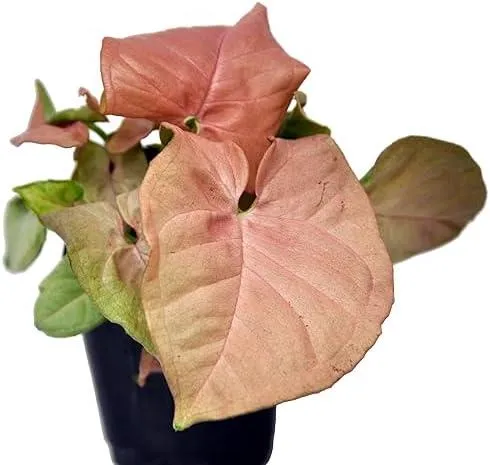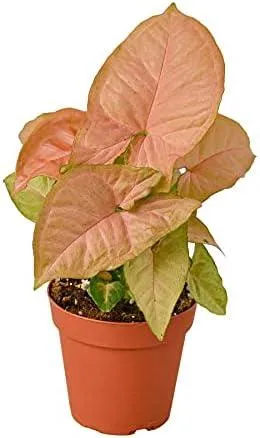Syngonium vs Philodendron: Which Vine Plant is Right for You?
If you’re looking for an easy-care houseplant to liven up your home, a trailing vine is a great option. Two popular choices are Syngonium and Philodendron. Both plants produce attractive leaves and are renowned for being nearly impossible to kill. But which one is better suited to your needs? Let’s break down the differences between Syngonium vs Philodendron plants.
Appearance
- Syngonium: Syngonium, also called Nephthytis or Arrowhead Vine, has heart-shaped leaves ranging from 3-10 inches long. The leaves come in various shades of green with white markings. Some cultivars produce leaves splashed or speckled with pink, tan, or white.
- Philodendron: Philodendron leaves come in many different shapes depending on the specific variety. Some common varieties have lobed heart-shaped leaves while others have more elongated split leaves. Philodendron leaves also vary in color from solid green to shades with shadows or edges in cream, pink, or red.
From my experience, Syngonium leaves generally have a more consistent shape while Philodendron leaves exhibit greater diversity. But Philodendron get extra points for their impressive variety of colors and patterns.
Growth Rate
Both plants are fast growers known for their ability to climb or trail. However, Syngonium tends to grow a bit faster in my experience:
- Syngonium: Medium-fast growth rate, can double in size within a year. Leaves tend to emerge singly rather than in clusters.
- Philodendron: Slower rate than Syngonium but still fairly rapid. New leaves often emerge as clusters rather than individually spaced.
So if you want a trailing plant that will fill out a space quickly, Syngonium may be the better pick. But Philodendron aren’t far behind and offer greater variety.
Care Requirements
Care-wise, both plants are incredibly low maintenance. Still, there are a few differences to be aware of:
- Watering: Syngonium are a bit more drought tolerant. I’ve basically forgotten to water mine for like a week with no issues! Philodendron appreciate slightly moister soil.
- Light: Though both plants adapt to low light, Syngonium will grow best and produce fuller leaves with more sunlight. Philodendron are happy in lower light spots.
- Fertilizer: Syngonium may not require fertilizer at all. Philodendron enjoy an occasional boost and will reward you with more robust growth.
So in summary, Syngonium care is simpler with less need for water or fertilizer. But don’t shy away from Philodendron – they’ll thrive on average care too!

Toxicity
A key consideration is whether you have pets or kids around. Here’s the lowdown on toxicity:
– Syngonium: Non-toxic to humans and pets, safe for households with children. Can kind of basically eat one without worries.
– Philodendron: Toxic if eaten, can cause mouth irritation and nausea. So probably not the best choice if you have little ones or pets that nibble on plants. Might wanna steer clear or keep it outta reach.
Unless you’ve got tiny terrors always sticking things in their mouths, either plant should be fine. But Philodendron toxicity gives it a slight edge for households with children or pets underfoot.
Price
Another factor is cost – and in this department, Syngonium beats Philodendron hands down. While both are affordable, in my local nurseries Syngonium typically sells for around half the price of most Philodendron varieties. Over time that savings adds up, especially if you’re an plantaholic like me always buying more!
Personal Preference
At the end of the day, selecting Syngonium vs. Philodendron comes down to aesthetics and what appeals most to your taste. I’m personally partial to Philodendron’s unique leaf shapes and funkier color variations. But you really can’t go wrong with the tried-and-true heart shapes of Syngonium.

Have you ever come across a rare Syngonium cultivar called ‘White Butterflies’? Its leaves are splashed with spidery white patterns that look like fluttering ghosts – stunning! Makes me wonder what crazy new types plant breeders will dream up next. Heck, maybe one day we’ll have Philodendron with glittery iridescent scales like a rainbow betta fish. Now that would be dope!
But let’s get real – as indoor houseplants, their sole purpose is to liven up our homes with natural beauty. So whichever plant suits your fancy is the right choice in the end.
Final Thoughts
To summarize the key differences between Syngonium vs Philodendron:
– Syngonium has hardier care needs, faster growth, and lower cost
– Philodendron offers more variety in leaf shapes/colors but requires slightly more care
– Syngonium is non-toxic while Philodendron needs to be kept away from pets/children
– You can’t go wrong with the trailing vines of either plant for an easy indoor green
Hope this breakdown helps you decide whether the arrow-shaped leaves of Syngonium or spectacular Philodendron varieties are a better fit for your home and lifestyle. As for me, I’ll take them both – if my apartment gets any fuller of plants, I may have to move into the jungle myself! Let me know if you have any other questions.
Syngonium vs Philodendron Comparison
| Characteristic | Syngonium | Philodendron |
|---|---|---|
| Leaf Shape | Heart-shaped | Various shapes like arrowhead, lobed or round |
| Leaf Color | Green variegated with white | Green variegated with white, pink or dark markings |
| Growth Rate | Fast | Medium to fast |
| Toxicity | Non-toxic | Non-toxic |
| Care Level | Easy | Easy |
| Water Needs | Allow soil to dry between waterings | Allow soil to partially dry between waterings |
| Humidity | High humidity preferred | Tolerates low humidity |
FAQ
-
What’s the difference between syngonium and philodendron?
Basically, syngonium and philodendron are both kinds of vines that people grow as houseplants. Syngoniums have arrow-shaped leaves with interesting patterns, while philodendron leaves are usually bigger and can have splits or holes in them. So they look a bit different, but they’re both easy to care for and will get long stems if you give them something to climb.

-
Do syngonium and philodendron need lots of sun?
Kinda. They both prefer indirect or filtered sunlight, not super bright direct rays all day. Too much sun can burn the leaves, but they won’t thrive without any light at all. I’d say put them in a spot with morning sun, or dappled afternoon sunlight. They seem to do well with a few hours each day. At the same time, they’re pretty flexible plants so don’t worry too much about the light – just don’t roast them!
-
How often do you water syngonium and philodendron?
Generally about once a week is good when the soil is dry an inch or so down. You don’t want the soil to stay soggy. However, it depends on the conditions – if it’s very sunny they may need a little extra drink now and then. The plants will show signs if thirsty, like drooping leaves. Just be careful not to overwater – that can cause root rot. Maybe wait till the top soil is quite dry before watering again to be safe.
-
Do syngonium and philodendron need fertilizer?
Most experts agree that giving them a dilute water-soluble houseplant fertilizer every few weeks during spring and summer helps them grow bigger and thrive. But you don’t have to be super strict about keeping to a schedule. They seem pretty resilient and don’t always show signs of lacking nutrients. I’ve gone months without fertilizing mine and they were fine! So perhaps just give them a little boost when you remember. Can’t hurt, but they’ll survive without it too.
-
How do you prune syngonium and philodendron?
You basically don’t have to prune these plants much, if at all. However, sometimes older stems get long and leggy. Then you can cut them back to encourage new growth. Cut somewhere above a leaf node using clean pruners. The stems should sprout fresh leaves. You can also trim off any brown or dying foliage. But go easy, as they rarely needs much pruning – they just keep growing! But is it worth severely cutting them back to fit a small space? Perhaps just move them instead.
-
What kind of pots do syngonium and philodendron do best in?
These vines really don’t care much about the pots – as long as there are drainage holes and the container isn’t too small to constrain their roots. They’ll grow in terra cotta, plastic, even glazed ceramic. The spiky arrowhead syngonium may puncture thin plastic over time. Nevertheless, you don’t have to get fancy – simple nursery pots work fine. Some people claim plants in attractive patterned pots are happier. On the other hand, I can’t swear I’ve seen syngonium or philodendron display emotion! So any pot that suits your decor should be just dandy.
-
Do syngonium and philodendron make good houseplants for beginners?
Absolutely, these are terrific low-maintenance starter plants. Since they tolerate low light and average household conditions pretty well, it’s hard to mess them up. No need for perfect care – just water when dry. While syngoniums require a bit more light to thrive, both can handle neglect amazingly. I should know – my collection survived law school finals week when I forgot them! It’s almost impossible to kill these guys. So any new plant parent of any skill level can succeed with syngonium or philodendron.

